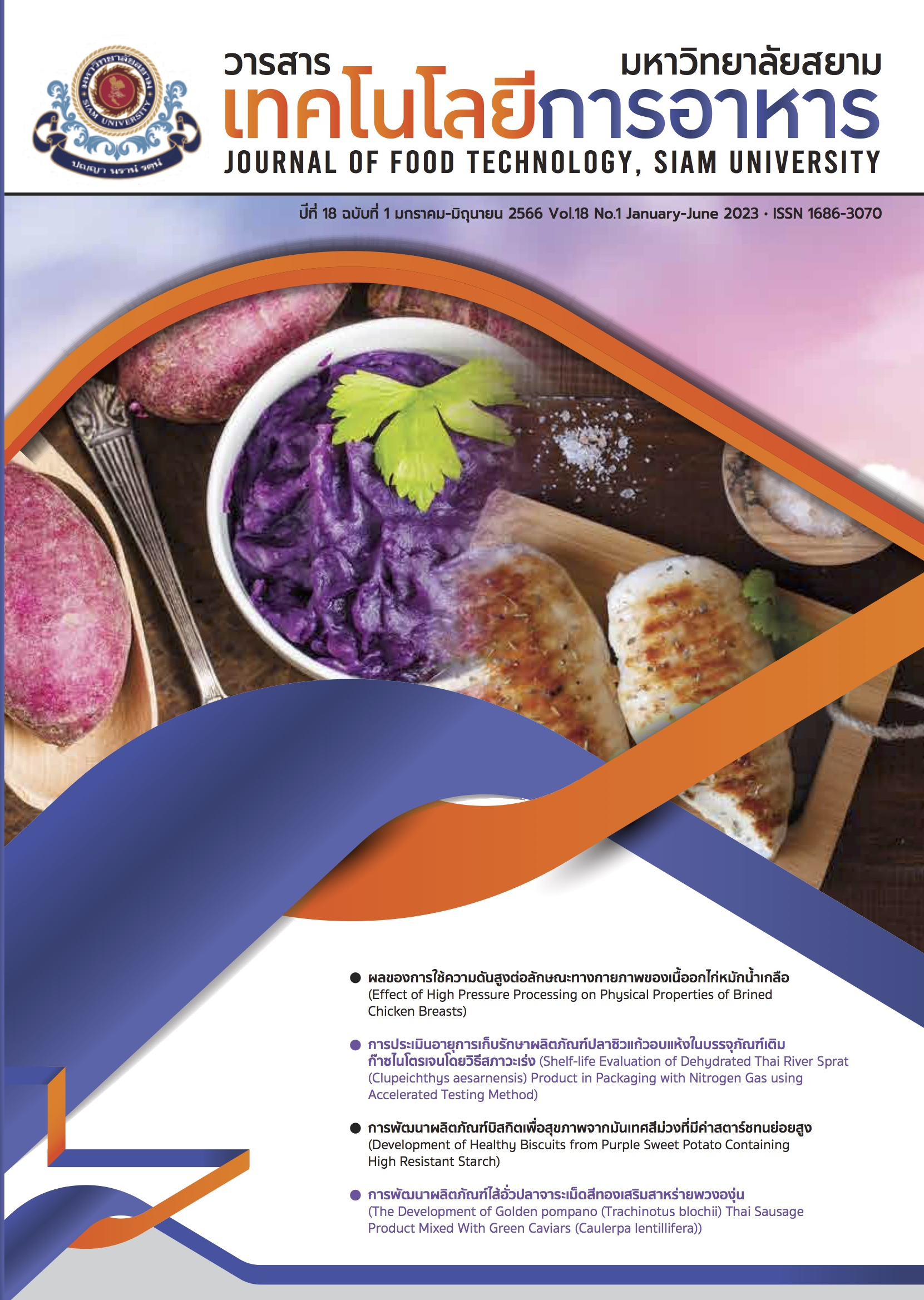Development of Healthy Biscuits from Purple Sweet Potato Containing High Resistant Starch
Main Article Content
Abstract
The research was aimed to develop high resistant starch - new healthy biscuits from purple sweet potato. The proximate composition of purple sweet potato found 41.58 g/100g carbohydrate, 0.30 g/100g fat, 0.59 g/100g protein, 1.08 g/100g crude fiber, 2.10 g/100g ash and 79 g/100g moisture. The appropriate conditions for processing purple sweet potato starch to have a high starch resistant value were steamed at 100oC for 30 min, then dried in a hot air tray oven at 70oC for 9 hours, ground to 100 mesh. The starch was hydrolyzed with two commercial enzymes, α-Amylase (1%w/v) at 70oC for 2 hours, followed by ß-Amylase (1%w/v) at 55oC for 2 hours and dried by spray dry. Results found that the 30 minute stremed process of purple sweet potato had antioxidant activity of 160.18 µmol TE/g using DPPH assay and resistant starch (%) at 18.96 with the lightness color of L*= 55.6, red-yellow hue (a*=15.10) and yellow-blue values (b*=-5.50). The purple sweet potato with high resistant starch content can be substituted for all-purpose flour in the basic formulation at the level of 50%. The produced high resistant starch - biscuits from purple sweet potato had sensory liking with overall liking score at moderately (7.45). The physical quality for hardness (Kg) at 0.74, fracturability at 0.76, color L* (18.06), a* (15.27), b* (9.52). This product had quality of total microorganisms, yeasts and molds < 10 est. (cfu/g), which was in the safe standard. The 100 consumer test of developed high resistant starch - new healthy biscuits from purple sweet potato, found that 90% accepted the product and 87% interested in purchasing the product.
Article Details

This work is licensed under a Creative Commons Attribution-NonCommercial-NoDerivatives 4.0 International License.
Copyrights of all articles in the Journal of Food Technology available in print or online are owned by Siam University and protected by law.
References
Marketwatch. (2023). Sweet potato market 2023 Is booming around the world by 2028. [Online] Available from https://www.marketwatch.com/press-release/sweet-potato-market-2023-is-booming-around-the-world-by-2028-2023-02-22. [Accessed March 11, 2023].
FAO. (2014). Production and area harvested. [Online] Available from http://faostat3.fao.org/browse/Q/QC/E [Accessed December 11, 2021].
Ray, R.C., Panda, S.K., Swain, M.R. and Sivakumar, P.S. (2011). Proximate composition and sensory evaluation of anthocyanin-rich purple sweet potato (Ipomoea batatas L.) wine. International Journal of Food Science and Technology. 47: 452–458.
Panda, V. and Sonkamble, M. (2012). Phytochemical constituents and Pharmacological activities of Ipomoea batatas L. (Lam) - A review. International Journal of Research in Phytochemistry and Pharmacology. 2(1): 25-34.
Tian, J., Chen, J., Lv, F., Chen, S., Chen, J., Liu, D. and Ye, X. (2016). Domestic cooking methods affect the phytochemical composition and antioxidant activity of purple-fleshed potatoes. Food Chemistry. 197: 1264–1270.
Charoenphun, N. (2017). Development of cookie products from sweet potato. Journal of Food Technology, Siam University. 1(13): 32-43. (in Thai).
Wannuvas, W., Kongnonkok, N. and Suksomboon, A. (2013). The effect of using purple sweet potato flour as a replacement for wheat flour on bread characteristics. Agricultural science journal. 44(2) (special): 421-424. (in Thai).
Toan, N.V. and Anh, N.V. (2018). Preparation and improved quality production of flour and the made biscuits from purple sweet potato. Journal of Food and Nutrition. 4: 1-14.
Englyst, H.N.and Hudson, G.J. (1992). The classification and measurement of dietary carbohydrates. Food Chemistry. 57: 15-21.
Fuller R. (1989). Probiotics in man and animals. Journal of Applied Bacteriology. 66: 365-378.
Mcorist, A.L., Miller, R.B., Bird, A.R., Keogh, J.B., Noakes, M., Topping, D.L. and Conlon, M.A. (2011). Fecal butyrate levels vary widely among individuals but are usually increased by a diet high in resistant starch. The Journal of Nutrition. 141: 883-889.
Remya, R. and Jyothi A.N. (2015). A comparative study on the resistant starch content from different botanical sources in relation to their physicochemical properties. Journal of Root Crops. 41: 37-47.
Boonkong, J. (2011). Resistant Starch: Starch effect on health. Journal of Food Technology, Siam University. 6: 1-8. (in Thai).
Han, X.Z., Ao, Z., Janaswamy, S., Jane, J.L., Chandrasekaran, S.R. and Hamaker, B.R. (2006). Development of a low glycemic maize starch: preparation and characterization. Biomacromolecules. 7: 1162-1168.
AOAC. (2000). Official Method of Analysis of AOAC International (17th ed.). The Association of Official Analytical Chemists: Maryland.
Davis, A.R., Fish, W.W. and Veazie, P.P. (2003). A rapid spectrophotometric method for analyzing lycopene content in tomato and tomato products. Postharvest Biology and Technology. 28: 425-430.
Sukkhown, P., Jangchud, K., Lorjaroenphon, Y. and Pirak, T. (2018). Flavored-functional protein hydrolysates from enzymatic hydrolysis of dried squid by-products: effect of drying method. Food hydrocolloids. 76: 103-112.
Nayak, B., Liu. R.H., Berrios, J.D., Tang, J.M. and Derito, C. (2011). Bioactivity of antioxidants in extruded products prepared from purple potato and dry Pea Flours. Journal of Agricultural and Food Chemistry. 59: 8233–8243.
AACC. (1995). Test kit resistant starch (AOAC official Method 2002.02; AACC Method 32-40.01). Ireland: Megazyme International.
Tirakawin, P. and Hongvarerat, J. (2010). Effect of factors in production process on quality of crispy durian chips. Agricultural science journal. 41: 265-268. (in Thai).
BAM. (2002). Food and Drug Administration bacteriological analytical manual (8th ed.). AOAC Internatioinal: USA.
Grace, M.H., Yousef, G.G., Gustafson, S.J., Truong, V.D., Yencho, G.C. and Lila, M.A. (2014). Phytochemical changes in phenolics, anthocyanins, ascorbic acid, and carotenoids associated with sweetpotato storage and impacts on bioactive properties. Food Chemistry. 145: 717–724.
Parkin, K.L. (2008). Enzymes. In: Fennema's food chemistry, Damodaran, S., K.L. Parkin and O.R. Fennema (eds.) (4th ed.). CRC Press, New York.
Chung, H.J., Lim, H.S. and Lim, S.T. (2006). Effect of partial gelatinization and retrogradation on the enzymatic digestion of waxy rice starch. Journal of Cereal Science. 43(3): 353-359.
Surojanametakul, V. (2006). Glycemic index: food and health. Jounal of food. 36: 183-187.
Raben, A., Tagliabue, A., Christensen, N., Madsen, J., Holst, J. and Astrup, A. (1994). Resistant starch: the effect on postprandial glycemia, hormonal response, and satiety. American Journal of Clinical Nutrition. 60: 544–551.
Ratithammatorn, T. (2017). Resistant Starch. Burapha Sciecne Journal. 22 (1): 166-176. (in Thai).


